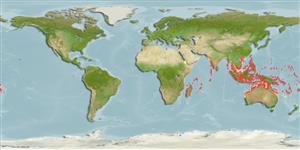Environment: milieu / climate zone / depth range / distribution range
Ecologie
marien; zoet water; brak water demersaal; katadroom (Ref. 51243). Tropical; 22°N - 27°S
Indo-Pacific: widespread in the tropical Indian Ocean and western Pacific. Known in Australia only from streams in the Kimberley regions of northern western Australia. Africa: widespread but relatively uncommon along east and southeast African coast and Madagascar (Ref. 7248, 52193). Mozambique; Lower Zambezi River (Ref. 39494). Most easily confused with Anguilla obscura and the surest way to distinguish them is by the count of vertebrae (Ref. 9828).
Grootte / Gewicht / Leeftijd
Maturity: Lm ? range ? - ? cm
Max length : 123 cm TL mannelijk / geslacht onbekend; (Ref. 6371); common length : 65.0 cm TL mannelijk / geslacht onbekend; (Ref. 2871); max. gerapporteerde leeftijd: 20 Jaren (Ref. 48660)
Dorsale stekels (totaal) : 0; Dorsale zachte stralen (totaal) : 240 - 245; Anale stekels: 0; Anale zachte stralen: 200 - 220; Wervels: 105 - 115.
Migratory species which breeds in the ocean (Ref. 52331, 79840). Lives in fresh water areas as an adult, in estuaries and seas as young (Ref. 12693). Descends to the sea to spawn. Inhabits freshwater streams and pools, preferring marshy habitats (Ref. 41236). Found in rivers and creeks, commonly over rock bottoms and in deeper pools. Seldom occurs in large rivers (Ref. 6028). Restricted to lowland (coastal) reaches of river systems (Ref. 7248). Feeds on small fishes, crustaceans and mollusks. Reported to breed east of Madagascar; the south equatorial current probably carries the eel larvae and elvers towards the east coast of Africa where local coastal currents guide the elvers to suitable rivers which they invade and they stay there until sexually mature, when they return to their breeding grounds (Ref. 13337). Caught with various types of nets. Sometimes used in the aquarium trade (Ref. 6028).
Levenscyclus en paargedrag
Maturities | Voortplanting | Spawnings | Egg(s) | Fecundities | Larven
Kottelat, M., 2013. The fishes of the inland waters of Southeast Asia: a catalogue and core bibliography of the fishes known to occur in freshwaters, mangroves and estuaries. The Raffles Bulletin of Zoology 2013 (Suppl. 27):1-663. (Ref. 94476)
Status op de Rode Lijst van het IUCN (Ref. 130435)
Gevaar voor de mens
Harmless
Gebruik door de mens
Visserij: van minder commercieel belang
Tools
Speciale rapporten
Download XML
Internetbronnen
Estimates based on models
Preferred temperature (Ref.
123201): 26.5 - 29.1, mean 28.3 °C (based on 1098 cells).
Fylogenetische diversiteitsindex (Ref.
82804): PD
50 = 0.5000 [Uniqueness, from 0.5 = low to 2.0 = high].
Bayesian length-weight: a=0.00076 (0.00037 - 0.00155), b=3.17 (3.00 - 3.34), in cm total length, based on LWR estimates for this Genus-body shape (Ref.
93245).
Trofisch niveau (Ref.
69278): 3.6 ±0.50 se; based on food items.
Weerstandsvermogen (Ref.
120179): laag, minimale populatieverdubbelingstijd 4,5-14 jaar (tmax=20).
Fishing Vulnerability (Ref.
59153): High to very high vulnerability (74 of 100).
Nutrients (Ref.
124155): Calcium = 58.7 [34.4, 111.3] mg/100g; Iron = 0.801 [0.472, 1.318] mg/100g; Protein = 18.8 [17.0, 20.8] %; Omega3 = 0.29 [0.14, 0.60] g/100g; Selenium = 150 [74, 289] μg/100g; VitaminA = 13.3 [3.1, 51.7] μg/100g; Zinc = 0.925 [0.650, 1.373] mg/100g (wet weight); based on
nutrient studies.
